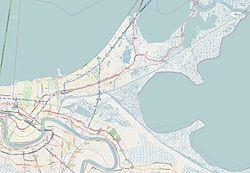Faubourg Livaudais
This article has multiple issues. Please help improve it or discuss these issues on the talk page. (Learn how and when to remove these messages)
|
Faubourg Livaudais | |
|---|---|
Neighborhood | |
| Coordinates: 29°56′10″N 90°05′10″W / 29.936°N 90.086°W | |
| Country | United States |
| State | Louisiana |
| City | New Orleans |
| Founded | 1832 |
| Founded by | Marie Celeste Marigny |
| Population | |
| • Demographics | Majority African American |
| Time zone | UTC-6 (Central (CST)) |
| • Summer (DST) | UTC-5 (CDT) |
| Area code | 504 |
The Faubourg Livaudais is a name of a neighborhood in central New Orleans that some people have re-adopted based upon the name of a former plantation that was in the area. The neighborhood is largely residential and contains mostly modest sized homes.
History
[edit]The Faubourg Livaudais was a plantation long before it was a neighborhood located Uptown New Orleans in Louisiana. The wife of Jacques Francois Enoul de Livaudais, Marie Celeste Marigny, sold her plantation to a syndicate of American businessmen. When the property was subdivided by the surveyor of Jefferson Parish, the Faubourg Livaudais was the name given to the neighborhood, founded in 1832. In the 1800s, many of the neighborhoods in the Jefferson Parish area were termed "faubourgs," a French word that was at the time roughly analogous to the modern concept of a suburb. These faubourgs were sometimes named after the plantations owner’s last name.[1] (Another prominent example is the Faubourg Marigny.)
Much of what has changed are the surroundings with new developments that have evolved over hundreds of years. When the neighborhood was first founded it was majority Americans, as opposed to French, Spanish or Creole. Caucasians took up most of the neighborhood but that gradually changed over the years. African Americans took up a large amount of the population and currently make up the majority of the inhabitants. Many people from different cultures and backgrounds stay in the area and live in a historical home.[2]
The neighborhood boundaries are located from St. Charles to Simon Bolivar and Jackson to Washington. The Faubourg Livaudais is historical for its cemetery and churches. There are free health screenings and other information given out to members of the community via email, Facebook, and newsletters. Members of the community try to keep the area clean and preserve it as best they can. Volunteers pick up trash, clean up houses, etc. Since Hurricane Katrina, there has been significant activity in the neighborhood restoring houses and building new homes on vacant lots.
Landmarks
[edit]The Faubourg Livaudais area is within the National Register Central City Historic District[3] and has many notable historical buildings and institutions, including up to about twenty churches throughout the area (Third Rose of Sharon Baptist Church, Gloryland Mt. Gillion Baptist Church, Second Mount Carmel Baptist Church, and Mt. Bethel Baptist Church, Pressing Onward Baptist Church, Second New Light Missionary Baptist Church, First African Baptist Church of New Orleans, etc.). These churches are very important to the Faubourg Livaudais because of many current residents' religious beliefs. [4] Another important historic landmark in the neighborhood is the former Dryades Public Library branch opened in 1915 with funding from Andrew Carnegie. It was the first public library in New Orleans that was open to black citizens.[5] The building is currently used by the James Singleton Charter School.
Geography
[edit]Every neighborhood has its own unique and different geography that describes the people that live there along with the culture of the neighborhood itself, and the Faubourg Livaudais is no different. Neighborhoods serve as geographical frames of orientation, encompassing the demographic, economic, and ecologic physiognomies of a particular place. The definition of a "neighborhood," however, relies heavily on perspective. Neighborhoods have different geographic gauges that assist different purposes. For example, metropolitan governments often define a neighborhood as a very large area for planning, providing services or maintaining infrastructure. The Faubourg Livaudais is a subsection of the area that many residents refer to as Central City, the Garden District, or just Uptown (depending on the exact location).
Schools/Education
[edit]The Faubourg Livaudais is located between St. Charles to Simon Bolivar and Jackson to Washington. There is one school within the boundaries of the neighborhood—James Singleton Charter School. However, other public charter and private schools are nearby.
Demographics
[edit]The neighborhood is home to both families and single people, and falls within the boundaries of Central City. The neighborhood is majority African American.
References
[edit]- ^ Soniat, Melony. "The Faubourgs" (PDF). The Louisiana Historical Society. Archived from the original (PDF) on April 26, 2014. Retrieved March 28, 2014.
- ^ http://www.nola.gov/neighborhood-engagement/organizations/faubourg-[permanent dead link] livaudais/
- ^ "National Register of Historical Places - LOUISIANA (LA), Orleans County".
- ^ Jerichohousing.org/community
- ^ "Little Known Black Librarian Facts: Dryades Branch of the New Orleans Public Library (New Orleans, Louisiana) : A Colored Carnegie Library". 17 August 2011.
- https://web.archive.org/web/20140426202152/http://www.neworleanspubliclibrary.org/~nopl/links/nolinks/faubourgs.pdf
- http://www.nola.gov/neighborhood-engagement/organizations/faubourg-livaudais/
- https://www.facebook.com/FaubourgLivaudais
- http://louisiana.gov/Government/Executive_Branch
- http://www.nola.gov/neighborhood-engagement/organizations/faubourg-livaudais
- http://nutrias.org/links/nolinks/faubourgs.pdf Archived 2014-06-11 at the Wayback Machine
- https://web.archive.org/web/20140429125930/http://neworleanscitybusiness.com/blog/tag/faubourg-livaudais/



